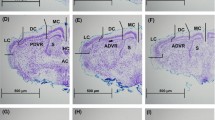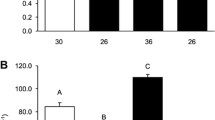Abstract
In a thermal gradient the preferred ambient temperature (T a pref) of chicken hatchlings is a few degrees lower than thermoneutrality. To investigate whether a correlation may exist between T a pref and the autonomic thermogenic capacity or not we studied a group of hatchlings (N = 15) exposed to cold at end-incubation, a procedure known to increase their postnatal thermogenesis. Chicken embryos were exposed to cold (34.5 °C instead of 38 °C) at days 18–20 of incubation. By comparison to Controls (N = 15), they hatched a few hours later, with similar body weight, body temperature, vocalization (number of sounds produced per unit time), and oxygen consumption (\(\dot{V}_{{{\text{O}}_{ 2} }}\), measured in a respirometer by an open-flow methodology). When exposed to slow cooling these hatchlings had a higher lower critical temperature (LCT) of thermoneutrality and higher \(\dot{V}_{{{\text{O}}_{ 2} }}\), and slightly higher vocalization than Controls. In a thermal gradient, T a pref averaged 34.3 ± 0.3 °C, or 1 °C higher than in Controls (33.4 ± 0.3 °C; P < 0.05), in proportion with their higher LCT (38 ± 0.1 °C instead of 36.7 ± 0.3 °C; P < 0.001), so that the T a pref − LCT difference (−3.6 ± 0.3 °C) was similar to Controls (−3.3 ± 0.3 °C). In conclusion, in chicken hatchlings T a pref was lower than LCT irrespective of the magnitude of their thermogenic response. It was estimated that, at T a pref, \(\dot{V}_{{{\text{O}}_{ 2} }}\) was ~20 % higher than at thermoneutrality. Such metabolic increase could carry some physiological advantage and the choice of T a pref may reflect the hatchling’s needs to maintain \(\dot{V}_{{{\text{O}}_{ 2} }}\) slightly elevated.





Similar content being viewed by others
Notes
‘Thermoneutrality’ is defined as range of ambient temperature at which temperature regulation is achieved only by control of sensible heat loss, i.e., without regulatory changes in metabolic heat production or evaporative heat loss (IUPS Thermal Commission 2001).
‘Lower critical temperature’ is the ambient temperature below which the rate of metabolic heat production of a resting thermoregulating tachymetabolic animal must be increased by shivering and/or nonshivering thermogenesis in order to maintain thermal balance (IUPS Thermal Commission 2001).
References
Al Awam K, Catana F, Mortola JP (2011) Thermogenic and vocalization responses to cold in chicken hatchling during normoxia and hypoxia. Behav Neurosci 125:74–83
Bicego KC, Barros RCH, Branco LGS (2007) Physiology of temperature regulation: comparative aspects. Comp Biochem Physiol A 147:616–639
Blumberg MS, Alberts JR (1990) Ultrasonic vocalizations by rat pups in the cold: an acoustic by-product of laryngeal braking? Behav Neurosci 104:808–817
Blumberg MS, Alberts JR (1991) Both hypoxia and milk deprivation diminish metabolic heat production and ultrasound emission by rat pups during cold exposure. Behav Neurosci 105:1030–1037
Bovans Brown (2012) Bovans Brown Management Guide—North America Edition—Centurion Poultry Inc., Lexington, GA. http://www.centurionpoultry.com/default/download_pdf/54
Cameron YL, Merazzi D, Mortola JP (2000) Variability of the breathing pattern in newborn rats: effects of ambient temperature in normoxia or hypoxia. Pediatr Res 47:813–818
Cobb (2012) Cobb Broiler Management Guide. Cobb-Vantress Inc., PO Box 1030, Siloam Springs, AR 72761, US. http://67.43.0.82/docs/default-source/guides/cobb-broiler-management-guide-(english).pdf?Status=Temp&sfvrsn=4
Depocas F, Hart JS (1957) Use of the Pauling oxygen analyzer for measurement of oxygen consumption of animals in open-circuit systems and in a short-lag, closed-circuit apparatus. J Appl Physiol 10:388–392
Friedman M, Baumgart S (2005) Thermal regulation. In: MacDonald MG, Mullett MD, Seshia MMK (Eds) Avery’s neonatology. Pathophysiology and management of the newborn, ch 24. Lippincott Williams and Wilkins, Philadelphia, pp 445–457. ISBN 0-7817-4643-4
Gordon CJ (1985) Relationship between autonomic and behavioral thermoregulation in the mouse. Physiol Behav 34:687–690
Gordon CJ (1987) Relationship between preferred ambient temperature and autonomic thermoregulatory function in rat. Am J Physiol 252:R1130–R1137
Gordon CJ (1990) Thermal biology of the laboratory rat. Physiol Behav 47:963–991
Gordon CJ (2012) Thermal physiology of laboratory mice: defining thermoneutrality. J Therm Biol 37:654–685
Hy-Line (2010) Hy-Line International Online Management Guide. http://www.hyline.com/RedBook/RedBook.html
IUPS Thermal Commission (2001) Glossary of terms for thermal physiology. 3rd Edn. Jpn J Physiol 51:245–280
Minne B, Decuypere E (1984) Effects of late prenatal temperatures on some thermoregulatory aspects in young chickens. Archiv Für Colderimentelle Veterinärmedizin 38:374–383
Mortola JP (2001) Respiratory physiology of newborn mammals. A comparative perspective. The Johns Hopkins Univ. Press, Baltimore, p 344, ISBN 0-8018-6497-6
Mortola JP (2006) Metabolic response to cooling temperatures in chicken embryos and hatchlings after cold incubation. Comp Biochem Physiol A 145:441–448
Mortola JP (2009) Gas exchange in avian embryos and hatchlings. Comp Biochem Physiol A 153:359–377
Mortola JP, Besterman AD (2007) Gaseous metabolism of the chicken embryo and hatchling during post-hypoxic recovery. Respir Physiol Neurobiol 156:212–219
Mount LE (1979) Adaptation to thermal environment—man and his productive animals. Baltimore: University Park Press, p 333, ISBN 0-8391-1420-6
Nichelmann M (2004) Perinatal epigenetic temperature adaptation in avian species: comparison of turkey and Muscovy duck. J Therm Biol 29:613–619
Szdzuy K, Fong LM, Mortola JP (2008) Oxygenation and establishment of thermogenesis in the avian embryo. Life Sci 82:50–58
Toro-Velasquez PA, Bicego KC, Mortola JP (2014). Temperature preference and thermogenesis of the chicken hatchling. Comp Physiol Biochem A (under review)
Tzschentke B, Nichelmann M (1997) Influence of prenatal and postnatal acclimation on nervous and peripheral thermoregulation. Ann N Y Acad Sci 813:87–94
Tzschentke B, Nichelmann M (1999) Development of avian thermoregulatory system during the early postnatal period: development of thermoregulatory set-point. Ornis Fenn 76:189–198
Tzschentke B, Basta D, Nichelmann M (2001) Epigenetic temperature adaptation in birds: peculiarities and similarities in comparison to acclimation. News Biomed Sci 1:26–31
Acknowledgments
We are grateful to Catherine Leurer, Sabine Elian and Yassmin Behzadian for their help in data analysis. Paula A. Toro-Velasquez was financially supported by a BEPE–FAPESP fellowship (Research Internship abroad, São Paulo Research Foundation, Brazil).
Author information
Authors and Affiliations
Corresponding author
Additional information
Communicated by G. Heldmaier.
Appendix
Appendix
These measurements were conducted to get some insights into a possibility raised in “Discussion”. The goal was to assess the effect of ambient temperature (T a) on body temperature (T b) during two protocols of moderate cooling. By the first protocol, T a was lowered to a target value and maintained constant. By the second protocol, T a oscillated above and below the target T a. The hatchling was placed in a respirometer that had ample windows for rapid equilibration of its internal temperature. The respirometer was transferred between a warm container and a cold container every 2 min for a total of 26 min, so as to generate cyclic oscillations in T a of ~15 °C (between 38 and 23 °C) around the average 30.6 °C. The second test consisted of maintaining the hatchling at this average T a (30.6 °C) for the whole time. These measurements were performed on four 1-day old hatchlings. In all cases, when T a oscillated, T b hardly changed; differently, when T a was maintained around the average value, T b invariably decreased (Fig. 5).
Rights and permissions
About this article
Cite this article
Toro-Velasquez, P.A., Mortola, J.P. Thermogenesis, vocalization, and temperature preference of 1-day-old chicken hatchlings after cold-exposure in late embryogenesis. J Comp Physiol B 184, 631–639 (2014). https://doi.org/10.1007/s00360-014-0828-x
Received:
Revised:
Accepted:
Published:
Issue Date:
DOI: https://doi.org/10.1007/s00360-014-0828-x




